BSBMGT516 Facilitate Continuous Improvement: A Detailed Case Study
VerifiedAdded on 2023/03/30
|19
|3166
|496
Case Study
AI Summary
This assignment provides a comprehensive solution to a case study focusing on management and continuous improvement. It covers key concepts such as quality systems, knowledge management, six sigma, and the importance of analytical and lateral thinking. The solution addresses how continuous improvement relates to other systems and provides practical recommendations for Quality Stock Enterprises, including utilizing participation techniques with employees, initiating continuous improvement activities, the importance of mentoring and coaching, sustainability practices, and the use of knowledge management systems. Furthermore, it discusses vision and mission statements, the implementation of Continuous Process Improvement (CPI) for BizOps Enterprise involving defining, measuring, analyzing, improving, and controlling processes, team composition, tool identification, suitability requirements, legislative considerations, communication frameworks, and the development of KPIs to measure achievements. The document is a valuable resource for students studying leadership and management, offering insights and practical applications of continuous improvement principles in a business context. Desklib offers a platform to explore similar solved assignments and study resources.
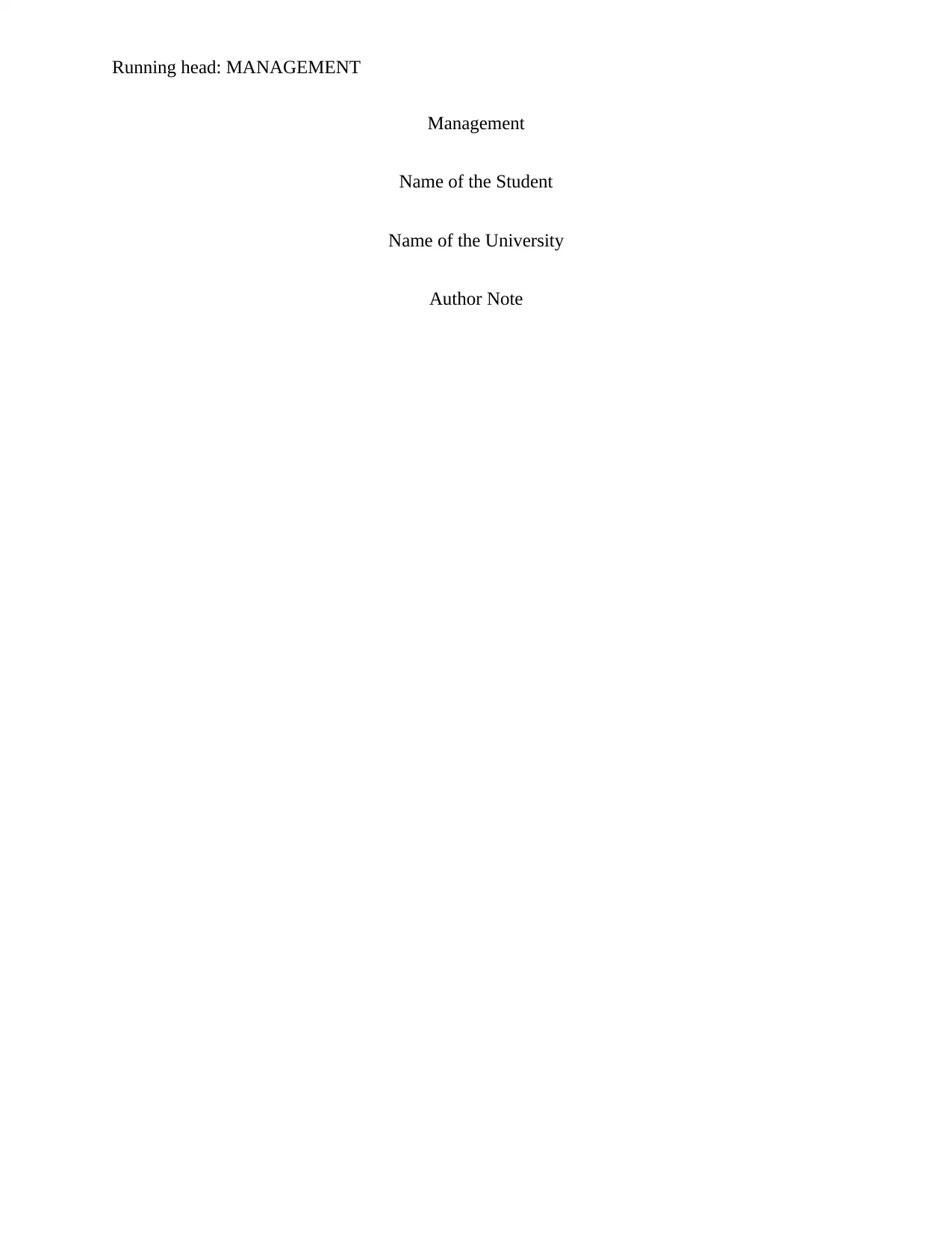
Running head: MANAGEMENT
Management
Name of the Student
Name of the University
Author Note
Management
Name of the Student
Name of the University
Author Note
Paraphrase This Document
Need a fresh take? Get an instant paraphrase of this document with our AI Paraphraser
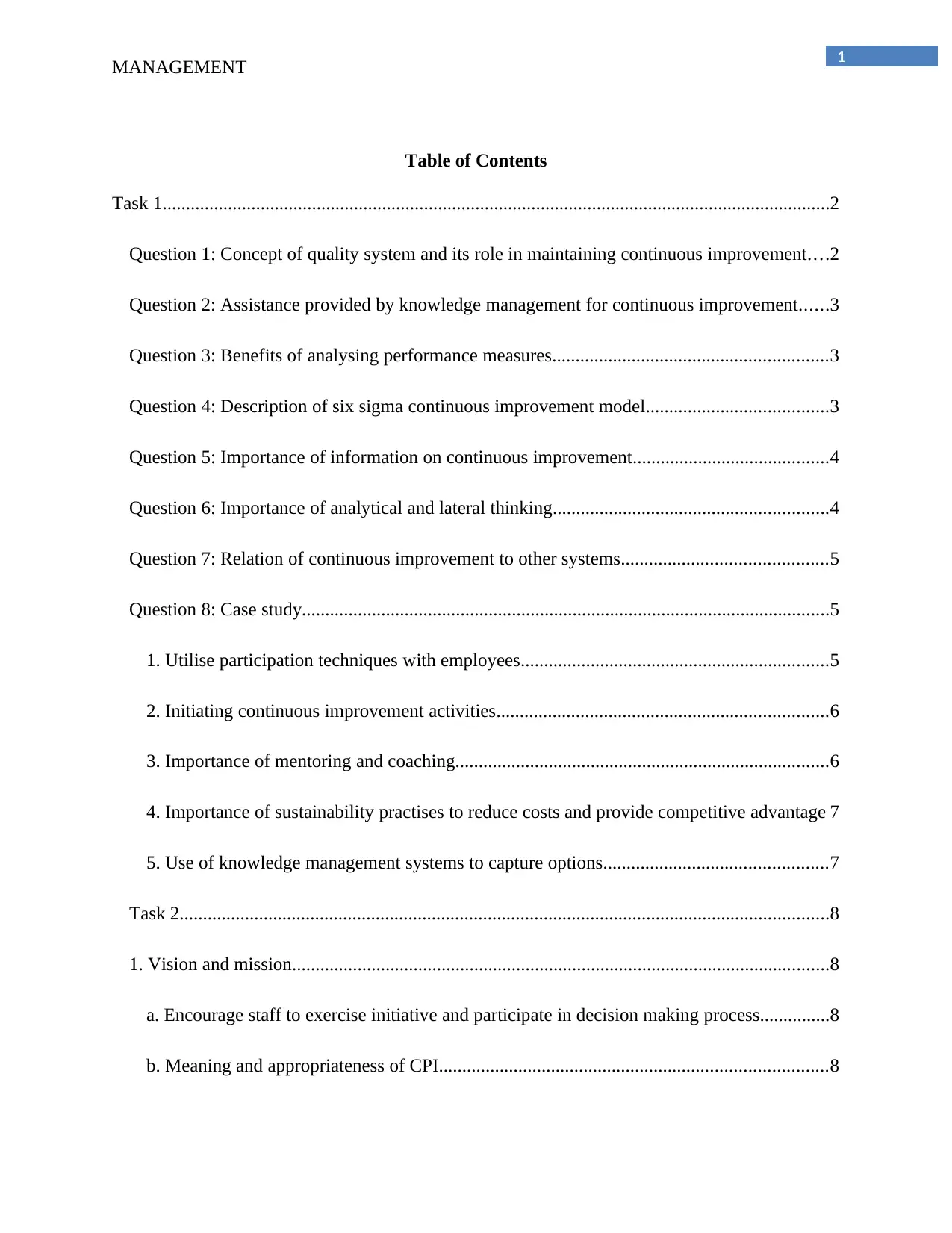
1
MANAGEMENT
Table of Contents
Task 1...............................................................................................................................................2
Question 1: Concept of quality system and its role in maintaining continuous improvement....2
Question 2: Assistance provided by knowledge management for continuous improvement......3
Question 3: Benefits of analysing performance measures...........................................................3
Question 4: Description of six sigma continuous improvement model.......................................3
Question 5: Importance of information on continuous improvement..........................................4
Question 6: Importance of analytical and lateral thinking...........................................................4
Question 7: Relation of continuous improvement to other systems............................................5
Question 8: Case study.................................................................................................................5
1. Utilise participation techniques with employees..................................................................5
2. Initiating continuous improvement activities.......................................................................6
3. Importance of mentoring and coaching................................................................................6
4. Importance of sustainability practises to reduce costs and provide competitive advantage 7
5. Use of knowledge management systems to capture options................................................7
Task 2...........................................................................................................................................8
1. Vision and mission...................................................................................................................8
a. Encourage staff to exercise initiative and participate in decision making process...............8
b. Meaning and appropriateness of CPI...................................................................................8
MANAGEMENT
Table of Contents
Task 1...............................................................................................................................................2
Question 1: Concept of quality system and its role in maintaining continuous improvement....2
Question 2: Assistance provided by knowledge management for continuous improvement......3
Question 3: Benefits of analysing performance measures...........................................................3
Question 4: Description of six sigma continuous improvement model.......................................3
Question 5: Importance of information on continuous improvement..........................................4
Question 6: Importance of analytical and lateral thinking...........................................................4
Question 7: Relation of continuous improvement to other systems............................................5
Question 8: Case study.................................................................................................................5
1. Utilise participation techniques with employees..................................................................5
2. Initiating continuous improvement activities.......................................................................6
3. Importance of mentoring and coaching................................................................................6
4. Importance of sustainability practises to reduce costs and provide competitive advantage 7
5. Use of knowledge management systems to capture options................................................7
Task 2...........................................................................................................................................8
1. Vision and mission...................................................................................................................8
a. Encourage staff to exercise initiative and participate in decision making process...............8
b. Meaning and appropriateness of CPI...................................................................................8
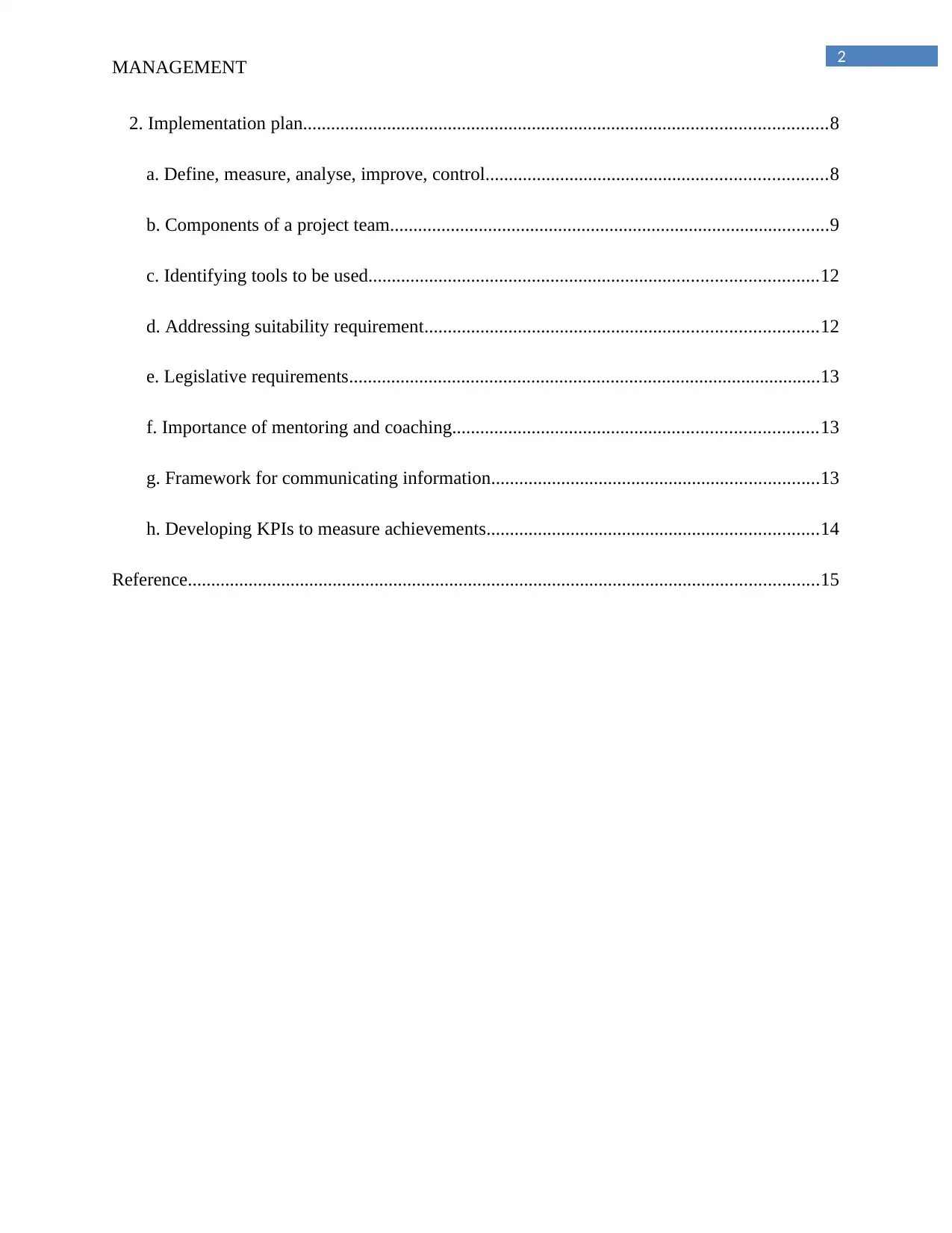
2
MANAGEMENT
2. Implementation plan................................................................................................................8
a. Define, measure, analyse, improve, control.........................................................................8
b. Components of a project team..............................................................................................9
c. Identifying tools to be used................................................................................................12
d. Addressing suitability requirement....................................................................................12
e. Legislative requirements.....................................................................................................13
f. Importance of mentoring and coaching..............................................................................13
g. Framework for communicating information......................................................................13
h. Developing KPIs to measure achievements.......................................................................14
Reference.......................................................................................................................................15
MANAGEMENT
2. Implementation plan................................................................................................................8
a. Define, measure, analyse, improve, control.........................................................................8
b. Components of a project team..............................................................................................9
c. Identifying tools to be used................................................................................................12
d. Addressing suitability requirement....................................................................................12
e. Legislative requirements.....................................................................................................13
f. Importance of mentoring and coaching..............................................................................13
g. Framework for communicating information......................................................................13
h. Developing KPIs to measure achievements.......................................................................14
Reference.......................................................................................................................................15
⊘ This is a preview!⊘
Do you want full access?
Subscribe today to unlock all pages.

Trusted by 1+ million students worldwide
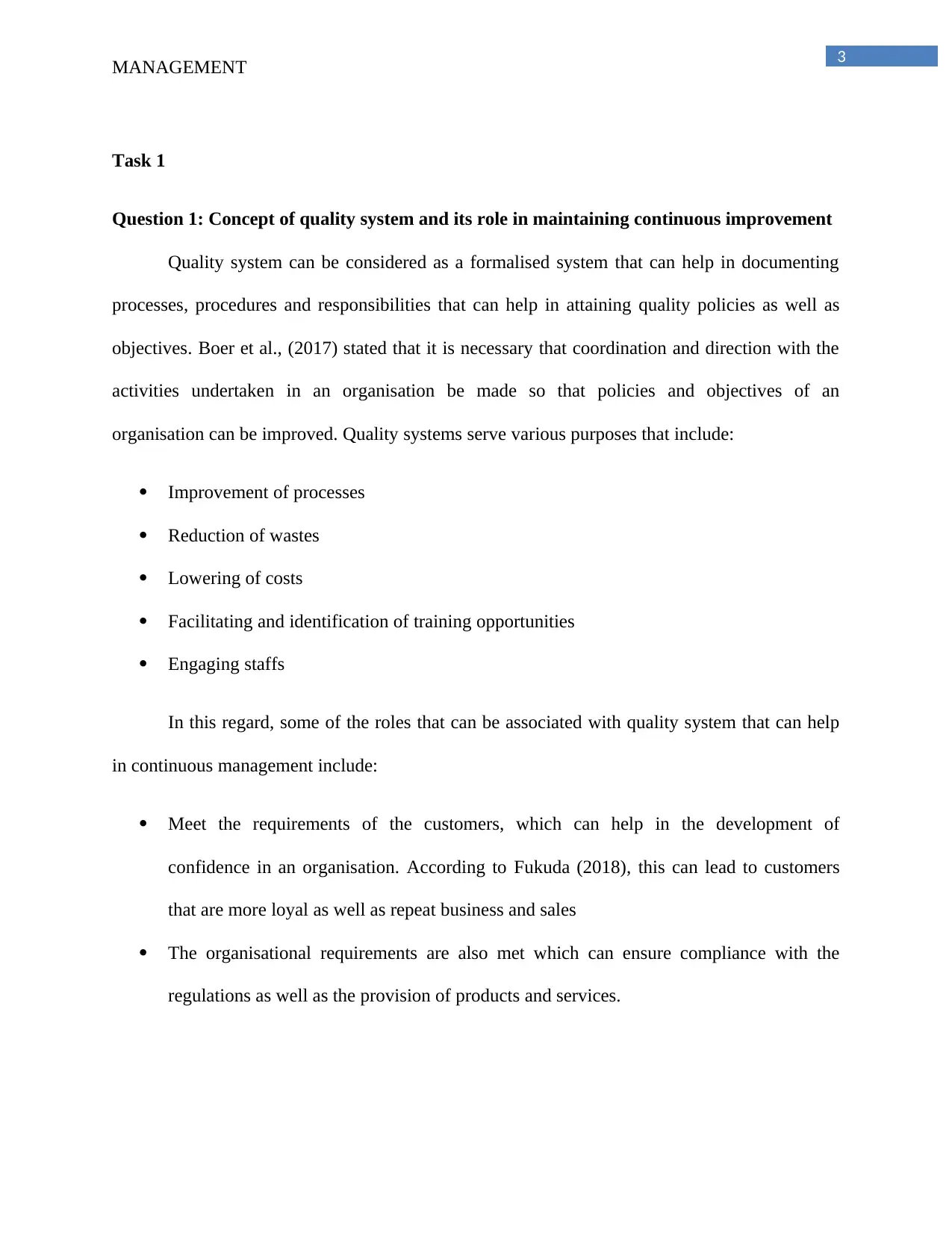
3
MANAGEMENT
Task 1
Question 1: Concept of quality system and its role in maintaining continuous improvement
Quality system can be considered as a formalised system that can help in documenting
processes, procedures and responsibilities that can help in attaining quality policies as well as
objectives. Boer et al., (2017) stated that it is necessary that coordination and direction with the
activities undertaken in an organisation be made so that policies and objectives of an
organisation can be improved. Quality systems serve various purposes that include:
Improvement of processes
Reduction of wastes
Lowering of costs
Facilitating and identification of training opportunities
Engaging staffs
In this regard, some of the roles that can be associated with quality system that can help
in continuous management include:
Meet the requirements of the customers, which can help in the development of
confidence in an organisation. According to Fukuda (2018), this can lead to customers
that are more loyal as well as repeat business and sales
The organisational requirements are also met which can ensure compliance with the
regulations as well as the provision of products and services.
MANAGEMENT
Task 1
Question 1: Concept of quality system and its role in maintaining continuous improvement
Quality system can be considered as a formalised system that can help in documenting
processes, procedures and responsibilities that can help in attaining quality policies as well as
objectives. Boer et al., (2017) stated that it is necessary that coordination and direction with the
activities undertaken in an organisation be made so that policies and objectives of an
organisation can be improved. Quality systems serve various purposes that include:
Improvement of processes
Reduction of wastes
Lowering of costs
Facilitating and identification of training opportunities
Engaging staffs
In this regard, some of the roles that can be associated with quality system that can help
in continuous management include:
Meet the requirements of the customers, which can help in the development of
confidence in an organisation. According to Fukuda (2018), this can lead to customers
that are more loyal as well as repeat business and sales
The organisational requirements are also met which can ensure compliance with the
regulations as well as the provision of products and services.
Paraphrase This Document
Need a fresh take? Get an instant paraphrase of this document with our AI Paraphraser
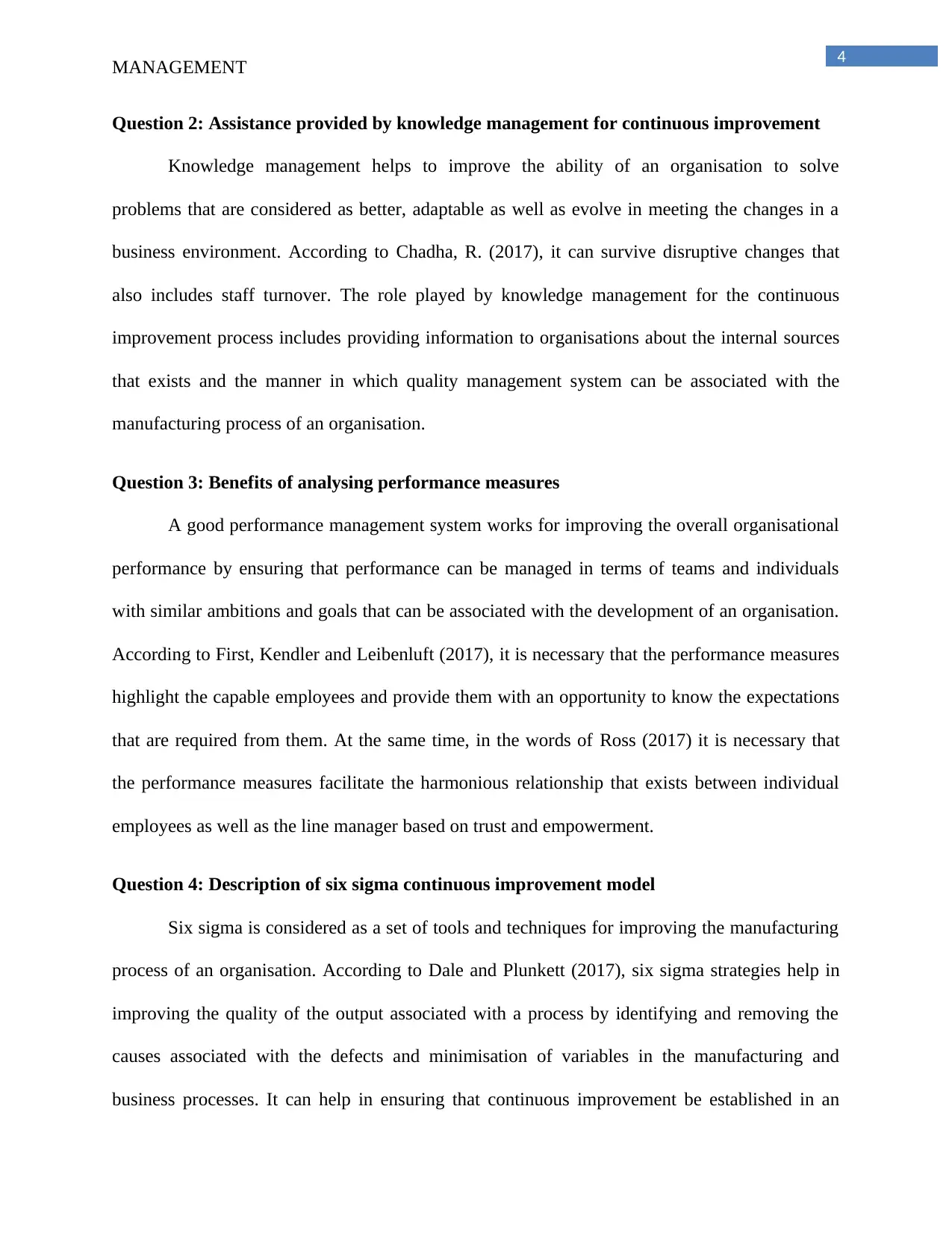
4
MANAGEMENT
Question 2: Assistance provided by knowledge management for continuous improvement
Knowledge management helps to improve the ability of an organisation to solve
problems that are considered as better, adaptable as well as evolve in meeting the changes in a
business environment. According to Chadha, R. (2017), it can survive disruptive changes that
also includes staff turnover. The role played by knowledge management for the continuous
improvement process includes providing information to organisations about the internal sources
that exists and the manner in which quality management system can be associated with the
manufacturing process of an organisation.
Question 3: Benefits of analysing performance measures
A good performance management system works for improving the overall organisational
performance by ensuring that performance can be managed in terms of teams and individuals
with similar ambitions and goals that can be associated with the development of an organisation.
According to First, Kendler and Leibenluft (2017), it is necessary that the performance measures
highlight the capable employees and provide them with an opportunity to know the expectations
that are required from them. At the same time, in the words of Ross (2017) it is necessary that
the performance measures facilitate the harmonious relationship that exists between individual
employees as well as the line manager based on trust and empowerment.
Question 4: Description of six sigma continuous improvement model
Six sigma is considered as a set of tools and techniques for improving the manufacturing
process of an organisation. According to Dale and Plunkett (2017), six sigma strategies help in
improving the quality of the output associated with a process by identifying and removing the
causes associated with the defects and minimisation of variables in the manufacturing and
business processes. It can help in ensuring that continuous improvement be established in an
MANAGEMENT
Question 2: Assistance provided by knowledge management for continuous improvement
Knowledge management helps to improve the ability of an organisation to solve
problems that are considered as better, adaptable as well as evolve in meeting the changes in a
business environment. According to Chadha, R. (2017), it can survive disruptive changes that
also includes staff turnover. The role played by knowledge management for the continuous
improvement process includes providing information to organisations about the internal sources
that exists and the manner in which quality management system can be associated with the
manufacturing process of an organisation.
Question 3: Benefits of analysing performance measures
A good performance management system works for improving the overall organisational
performance by ensuring that performance can be managed in terms of teams and individuals
with similar ambitions and goals that can be associated with the development of an organisation.
According to First, Kendler and Leibenluft (2017), it is necessary that the performance measures
highlight the capable employees and provide them with an opportunity to know the expectations
that are required from them. At the same time, in the words of Ross (2017) it is necessary that
the performance measures facilitate the harmonious relationship that exists between individual
employees as well as the line manager based on trust and empowerment.
Question 4: Description of six sigma continuous improvement model
Six sigma is considered as a set of tools and techniques for improving the manufacturing
process of an organisation. According to Dale and Plunkett (2017), six sigma strategies help in
improving the quality of the output associated with a process by identifying and removing the
causes associated with the defects and minimisation of variables in the manufacturing and
business processes. It can help in ensuring that continuous improvement be established in an
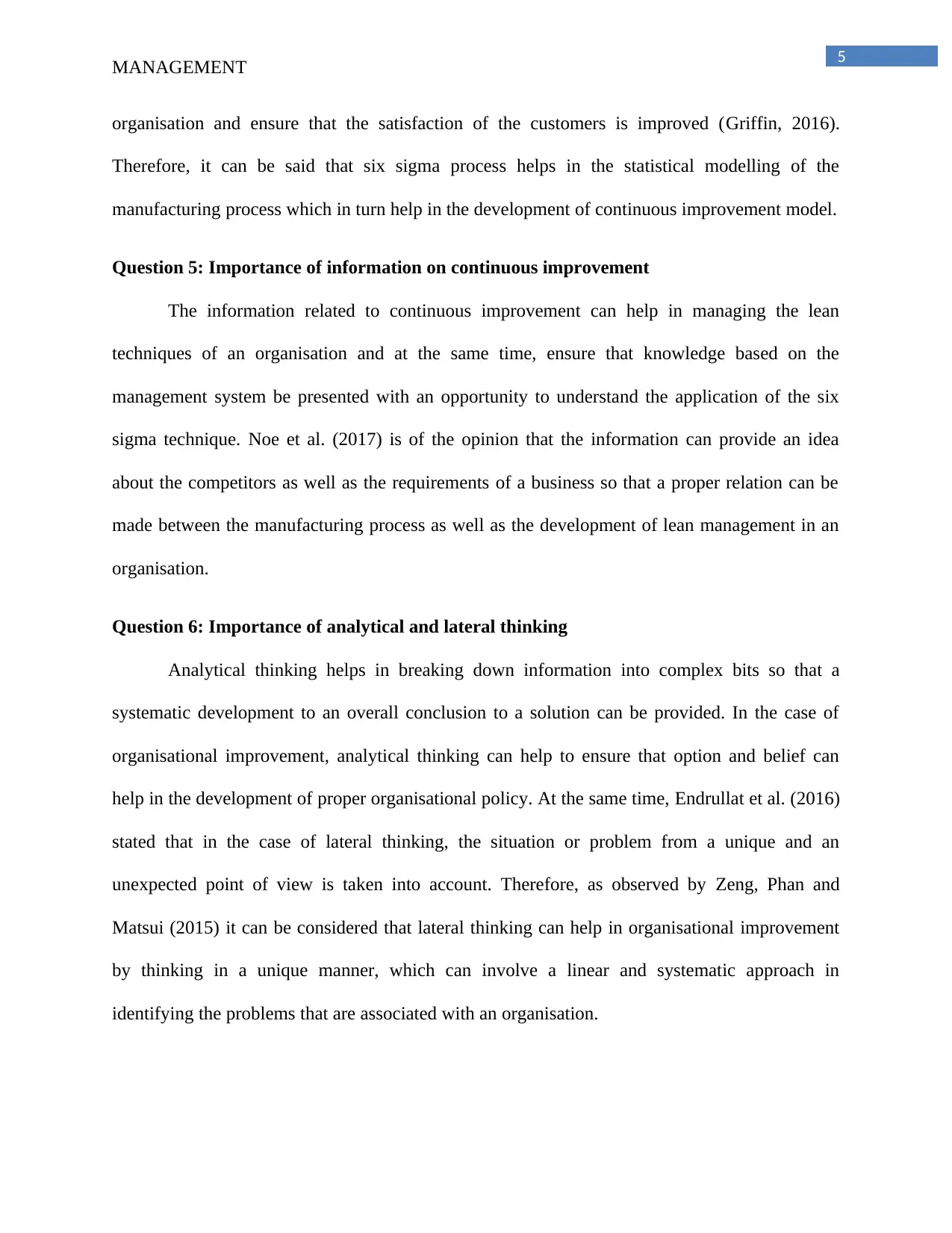
5
MANAGEMENT
organisation and ensure that the satisfaction of the customers is improved (Griffin, 2016).
Therefore, it can be said that six sigma process helps in the statistical modelling of the
manufacturing process which in turn help in the development of continuous improvement model.
Question 5: Importance of information on continuous improvement
The information related to continuous improvement can help in managing the lean
techniques of an organisation and at the same time, ensure that knowledge based on the
management system be presented with an opportunity to understand the application of the six
sigma technique. Noe et al. (2017) is of the opinion that the information can provide an idea
about the competitors as well as the requirements of a business so that a proper relation can be
made between the manufacturing process as well as the development of lean management in an
organisation.
Question 6: Importance of analytical and lateral thinking
Analytical thinking helps in breaking down information into complex bits so that a
systematic development to an overall conclusion to a solution can be provided. In the case of
organisational improvement, analytical thinking can help to ensure that option and belief can
help in the development of proper organisational policy. At the same time, Endrullat et al. (2016)
stated that in the case of lateral thinking, the situation or problem from a unique and an
unexpected point of view is taken into account. Therefore, as observed by Zeng, Phan and
Matsui (2015) it can be considered that lateral thinking can help in organisational improvement
by thinking in a unique manner, which can involve a linear and systematic approach in
identifying the problems that are associated with an organisation.
MANAGEMENT
organisation and ensure that the satisfaction of the customers is improved (Griffin, 2016).
Therefore, it can be said that six sigma process helps in the statistical modelling of the
manufacturing process which in turn help in the development of continuous improvement model.
Question 5: Importance of information on continuous improvement
The information related to continuous improvement can help in managing the lean
techniques of an organisation and at the same time, ensure that knowledge based on the
management system be presented with an opportunity to understand the application of the six
sigma technique. Noe et al. (2017) is of the opinion that the information can provide an idea
about the competitors as well as the requirements of a business so that a proper relation can be
made between the manufacturing process as well as the development of lean management in an
organisation.
Question 6: Importance of analytical and lateral thinking
Analytical thinking helps in breaking down information into complex bits so that a
systematic development to an overall conclusion to a solution can be provided. In the case of
organisational improvement, analytical thinking can help to ensure that option and belief can
help in the development of proper organisational policy. At the same time, Endrullat et al. (2016)
stated that in the case of lateral thinking, the situation or problem from a unique and an
unexpected point of view is taken into account. Therefore, as observed by Zeng, Phan and
Matsui (2015) it can be considered that lateral thinking can help in organisational improvement
by thinking in a unique manner, which can involve a linear and systematic approach in
identifying the problems that are associated with an organisation.
⊘ This is a preview!⊘
Do you want full access?
Subscribe today to unlock all pages.

Trusted by 1+ million students worldwide
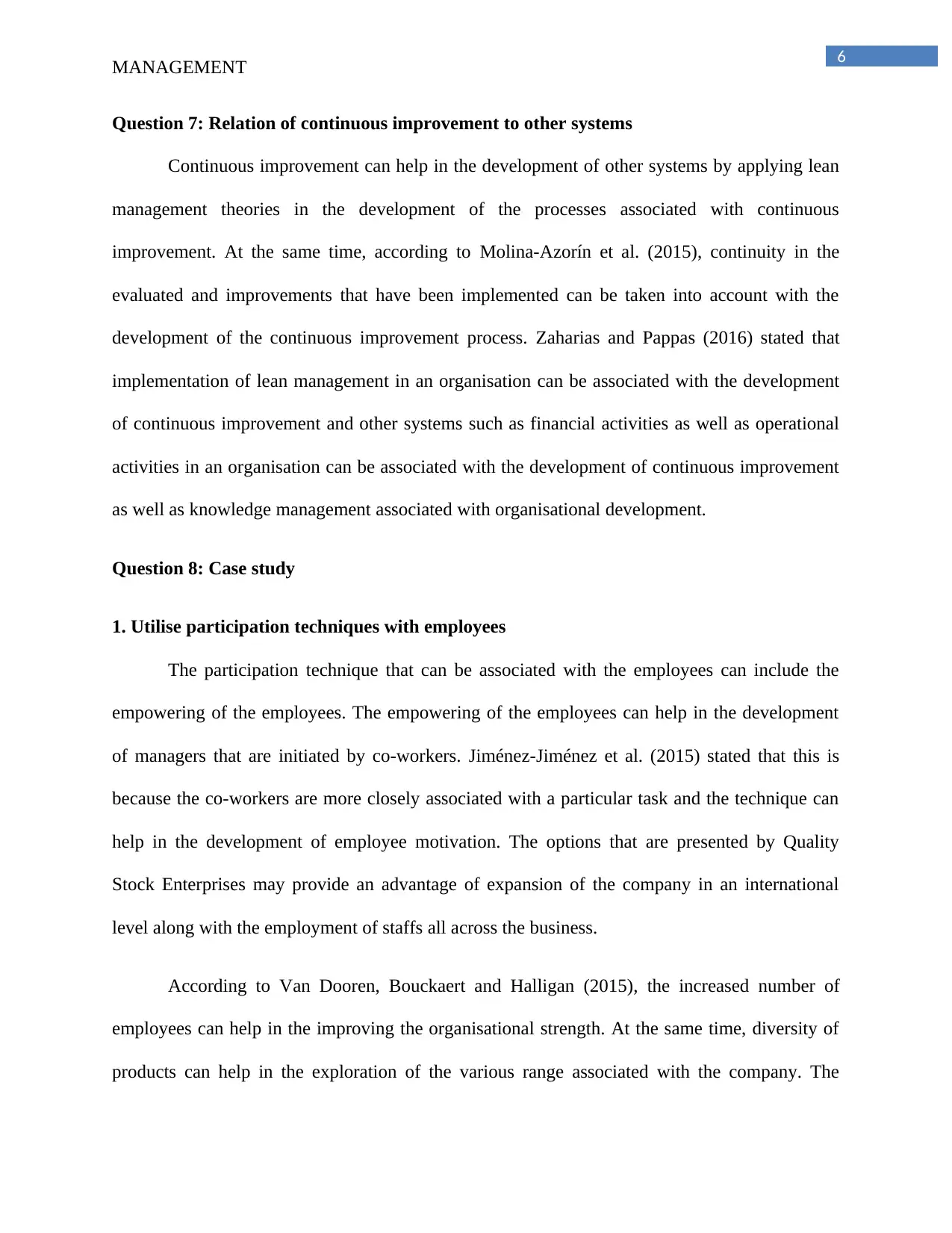
6
MANAGEMENT
Question 7: Relation of continuous improvement to other systems
Continuous improvement can help in the development of other systems by applying lean
management theories in the development of the processes associated with continuous
improvement. At the same time, according to Molina-Azorín et al. (2015), continuity in the
evaluated and improvements that have been implemented can be taken into account with the
development of the continuous improvement process. Zaharias and Pappas (2016) stated that
implementation of lean management in an organisation can be associated with the development
of continuous improvement and other systems such as financial activities as well as operational
activities in an organisation can be associated with the development of continuous improvement
as well as knowledge management associated with organisational development.
Question 8: Case study
1. Utilise participation techniques with employees
The participation technique that can be associated with the employees can include the
empowering of the employees. The empowering of the employees can help in the development
of managers that are initiated by co-workers. Jiménez-Jiménez et al. (2015) stated that this is
because the co-workers are more closely associated with a particular task and the technique can
help in the development of employee motivation. The options that are presented by Quality
Stock Enterprises may provide an advantage of expansion of the company in an international
level along with the employment of staffs all across the business.
According to Van Dooren, Bouckaert and Halligan (2015), the increased number of
employees can help in the improving the organisational strength. At the same time, diversity of
products can help in the exploration of the various range associated with the company. The
MANAGEMENT
Question 7: Relation of continuous improvement to other systems
Continuous improvement can help in the development of other systems by applying lean
management theories in the development of the processes associated with continuous
improvement. At the same time, according to Molina-Azorín et al. (2015), continuity in the
evaluated and improvements that have been implemented can be taken into account with the
development of the continuous improvement process. Zaharias and Pappas (2016) stated that
implementation of lean management in an organisation can be associated with the development
of continuous improvement and other systems such as financial activities as well as operational
activities in an organisation can be associated with the development of continuous improvement
as well as knowledge management associated with organisational development.
Question 8: Case study
1. Utilise participation techniques with employees
The participation technique that can be associated with the employees can include the
empowering of the employees. The empowering of the employees can help in the development
of managers that are initiated by co-workers. Jiménez-Jiménez et al. (2015) stated that this is
because the co-workers are more closely associated with a particular task and the technique can
help in the development of employee motivation. The options that are presented by Quality
Stock Enterprises may provide an advantage of expansion of the company in an international
level along with the employment of staffs all across the business.
According to Van Dooren, Bouckaert and Halligan (2015), the increased number of
employees can help in the improving the organisational strength. At the same time, diversity of
products can help in the exploration of the various range associated with the company. The
Paraphrase This Document
Need a fresh take? Get an instant paraphrase of this document with our AI Paraphraser
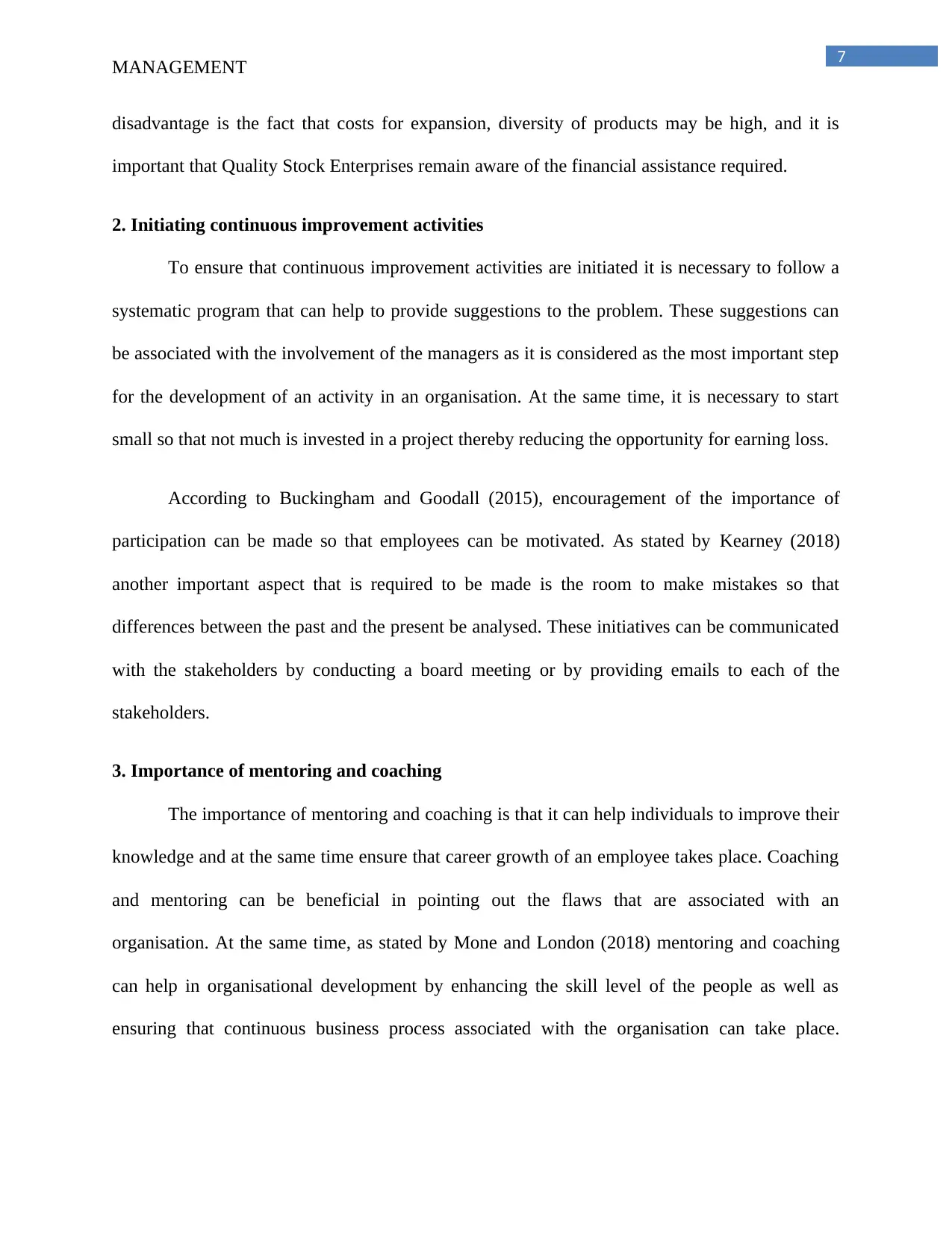
7
MANAGEMENT
disadvantage is the fact that costs for expansion, diversity of products may be high, and it is
important that Quality Stock Enterprises remain aware of the financial assistance required.
2. Initiating continuous improvement activities
To ensure that continuous improvement activities are initiated it is necessary to follow a
systematic program that can help to provide suggestions to the problem. These suggestions can
be associated with the involvement of the managers as it is considered as the most important step
for the development of an activity in an organisation. At the same time, it is necessary to start
small so that not much is invested in a project thereby reducing the opportunity for earning loss.
According to Buckingham and Goodall (2015), encouragement of the importance of
participation can be made so that employees can be motivated. As stated by Kearney (2018)
another important aspect that is required to be made is the room to make mistakes so that
differences between the past and the present be analysed. These initiatives can be communicated
with the stakeholders by conducting a board meeting or by providing emails to each of the
stakeholders.
3. Importance of mentoring and coaching
The importance of mentoring and coaching is that it can help individuals to improve their
knowledge and at the same time ensure that career growth of an employee takes place. Coaching
and mentoring can be beneficial in pointing out the flaws that are associated with an
organisation. At the same time, as stated by Mone and London (2018) mentoring and coaching
can help in organisational development by enhancing the skill level of the people as well as
ensuring that continuous business process associated with the organisation can take place.
MANAGEMENT
disadvantage is the fact that costs for expansion, diversity of products may be high, and it is
important that Quality Stock Enterprises remain aware of the financial assistance required.
2. Initiating continuous improvement activities
To ensure that continuous improvement activities are initiated it is necessary to follow a
systematic program that can help to provide suggestions to the problem. These suggestions can
be associated with the involvement of the managers as it is considered as the most important step
for the development of an activity in an organisation. At the same time, it is necessary to start
small so that not much is invested in a project thereby reducing the opportunity for earning loss.
According to Buckingham and Goodall (2015), encouragement of the importance of
participation can be made so that employees can be motivated. As stated by Kearney (2018)
another important aspect that is required to be made is the room to make mistakes so that
differences between the past and the present be analysed. These initiatives can be communicated
with the stakeholders by conducting a board meeting or by providing emails to each of the
stakeholders.
3. Importance of mentoring and coaching
The importance of mentoring and coaching is that it can help individuals to improve their
knowledge and at the same time ensure that career growth of an employee takes place. Coaching
and mentoring can be beneficial in pointing out the flaws that are associated with an
organisation. At the same time, as stated by Mone and London (2018) mentoring and coaching
can help in organisational development by enhancing the skill level of the people as well as
ensuring that continuous business process associated with the organisation can take place.
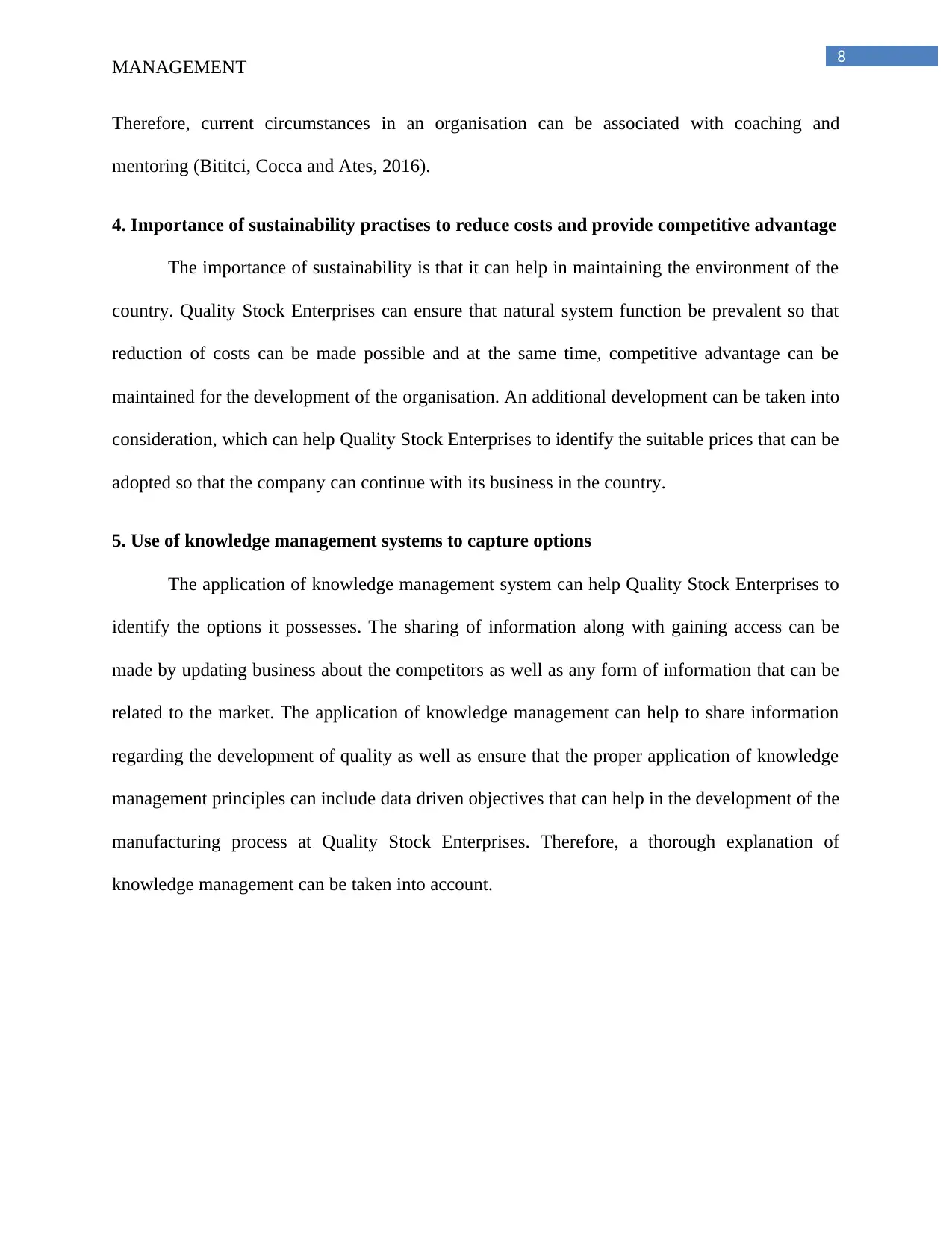
8
MANAGEMENT
Therefore, current circumstances in an organisation can be associated with coaching and
mentoring (Bititci, Cocca and Ates, 2016).
4. Importance of sustainability practises to reduce costs and provide competitive advantage
The importance of sustainability is that it can help in maintaining the environment of the
country. Quality Stock Enterprises can ensure that natural system function be prevalent so that
reduction of costs can be made possible and at the same time, competitive advantage can be
maintained for the development of the organisation. An additional development can be taken into
consideration, which can help Quality Stock Enterprises to identify the suitable prices that can be
adopted so that the company can continue with its business in the country.
5. Use of knowledge management systems to capture options
The application of knowledge management system can help Quality Stock Enterprises to
identify the options it possesses. The sharing of information along with gaining access can be
made by updating business about the competitors as well as any form of information that can be
related to the market. The application of knowledge management can help to share information
regarding the development of quality as well as ensure that the proper application of knowledge
management principles can include data driven objectives that can help in the development of the
manufacturing process at Quality Stock Enterprises. Therefore, a thorough explanation of
knowledge management can be taken into account.
MANAGEMENT
Therefore, current circumstances in an organisation can be associated with coaching and
mentoring (Bititci, Cocca and Ates, 2016).
4. Importance of sustainability practises to reduce costs and provide competitive advantage
The importance of sustainability is that it can help in maintaining the environment of the
country. Quality Stock Enterprises can ensure that natural system function be prevalent so that
reduction of costs can be made possible and at the same time, competitive advantage can be
maintained for the development of the organisation. An additional development can be taken into
consideration, which can help Quality Stock Enterprises to identify the suitable prices that can be
adopted so that the company can continue with its business in the country.
5. Use of knowledge management systems to capture options
The application of knowledge management system can help Quality Stock Enterprises to
identify the options it possesses. The sharing of information along with gaining access can be
made by updating business about the competitors as well as any form of information that can be
related to the market. The application of knowledge management can help to share information
regarding the development of quality as well as ensure that the proper application of knowledge
management principles can include data driven objectives that can help in the development of the
manufacturing process at Quality Stock Enterprises. Therefore, a thorough explanation of
knowledge management can be taken into account.
⊘ This is a preview!⊘
Do you want full access?
Subscribe today to unlock all pages.

Trusted by 1+ million students worldwide
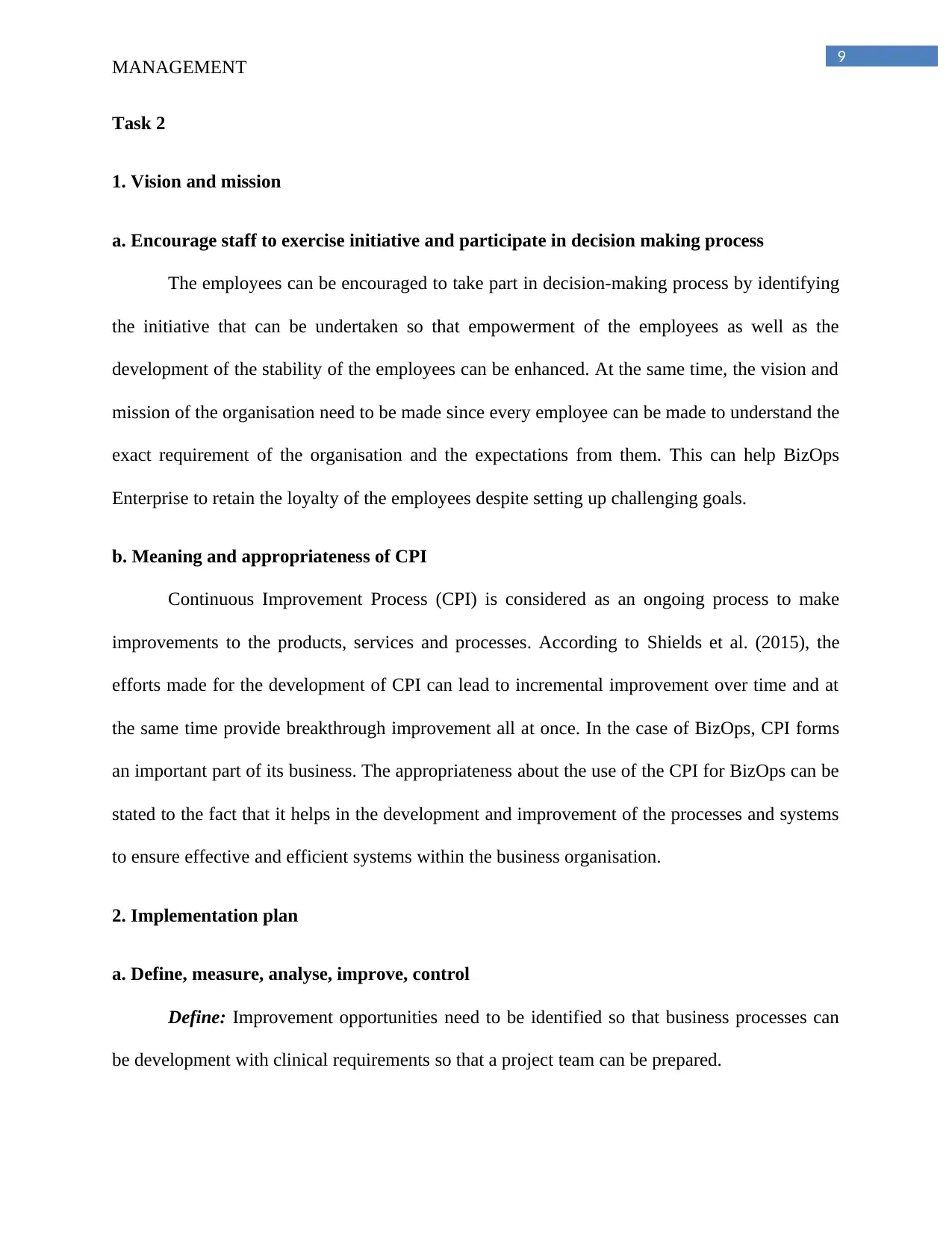
9
MANAGEMENT
Task 2
1. Vision and mission
a. Encourage staff to exercise initiative and participate in decision making process
The employees can be encouraged to take part in decision-making process by identifying
the initiative that can be undertaken so that empowerment of the employees as well as the
development of the stability of the employees can be enhanced. At the same time, the vision and
mission of the organisation need to be made since every employee can be made to understand the
exact requirement of the organisation and the expectations from them. This can help BizOps
Enterprise to retain the loyalty of the employees despite setting up challenging goals.
b. Meaning and appropriateness of CPI
Continuous Improvement Process (CPI) is considered as an ongoing process to make
improvements to the products, services and processes. According to Shields et al. (2015), the
efforts made for the development of CPI can lead to incremental improvement over time and at
the same time provide breakthrough improvement all at once. In the case of BizOps, CPI forms
an important part of its business. The appropriateness about the use of the CPI for BizOps can be
stated to the fact that it helps in the development and improvement of the processes and systems
to ensure effective and efficient systems within the business organisation.
2. Implementation plan
a. Define, measure, analyse, improve, control
Define: Improvement opportunities need to be identified so that business processes can
be development with clinical requirements so that a project team can be prepared.
MANAGEMENT
Task 2
1. Vision and mission
a. Encourage staff to exercise initiative and participate in decision making process
The employees can be encouraged to take part in decision-making process by identifying
the initiative that can be undertaken so that empowerment of the employees as well as the
development of the stability of the employees can be enhanced. At the same time, the vision and
mission of the organisation need to be made since every employee can be made to understand the
exact requirement of the organisation and the expectations from them. This can help BizOps
Enterprise to retain the loyalty of the employees despite setting up challenging goals.
b. Meaning and appropriateness of CPI
Continuous Improvement Process (CPI) is considered as an ongoing process to make
improvements to the products, services and processes. According to Shields et al. (2015), the
efforts made for the development of CPI can lead to incremental improvement over time and at
the same time provide breakthrough improvement all at once. In the case of BizOps, CPI forms
an important part of its business. The appropriateness about the use of the CPI for BizOps can be
stated to the fact that it helps in the development and improvement of the processes and systems
to ensure effective and efficient systems within the business organisation.
2. Implementation plan
a. Define, measure, analyse, improve, control
Define: Improvement opportunities need to be identified so that business processes can
be development with clinical requirements so that a project team can be prepared.
Paraphrase This Document
Need a fresh take? Get an instant paraphrase of this document with our AI Paraphraser
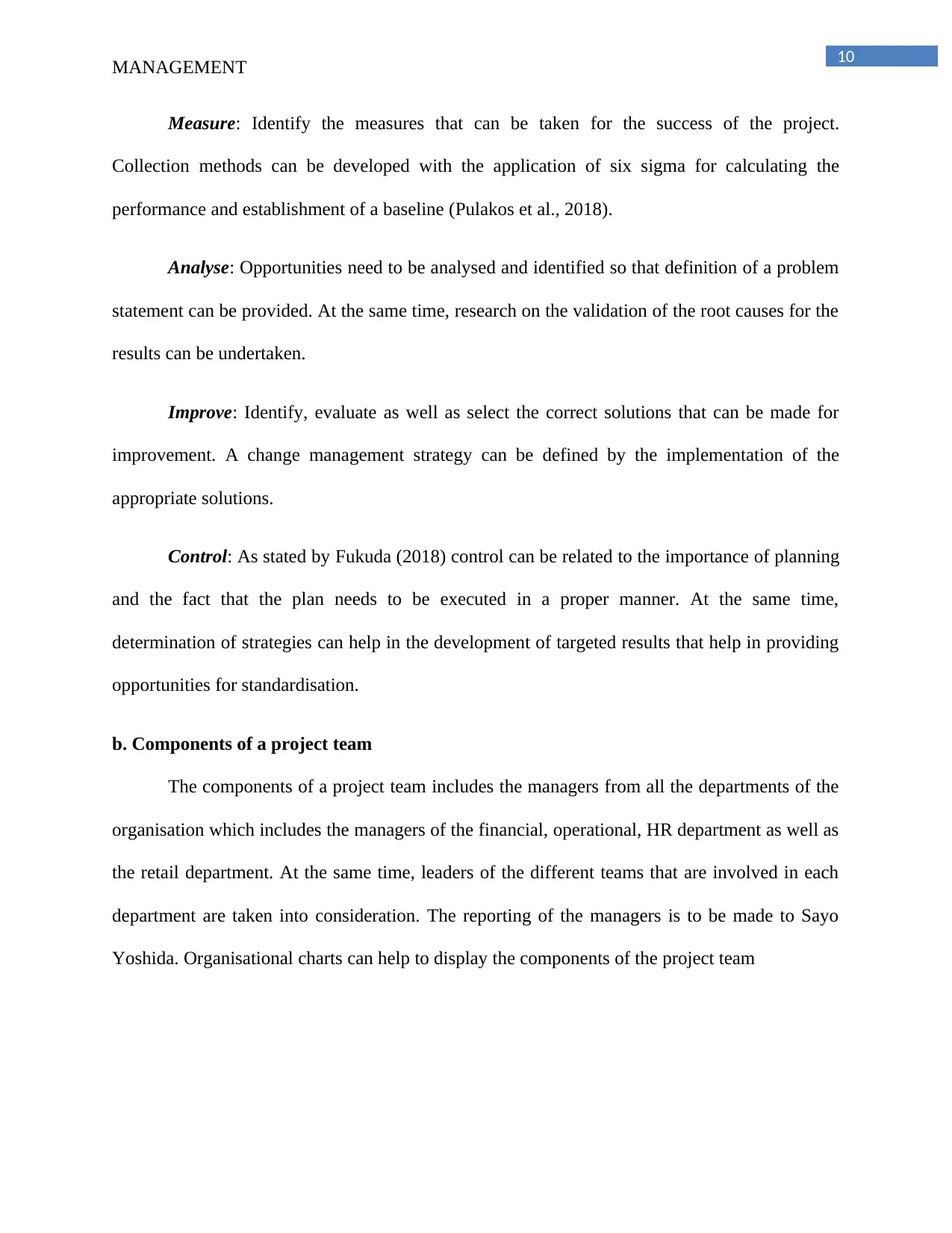
10
MANAGEMENT
Measure: Identify the measures that can be taken for the success of the project.
Collection methods can be developed with the application of six sigma for calculating the
performance and establishment of a baseline (Pulakos et al., 2018).
Analyse: Opportunities need to be analysed and identified so that definition of a problem
statement can be provided. At the same time, research on the validation of the root causes for the
results can be undertaken.
Improve: Identify, evaluate as well as select the correct solutions that can be made for
improvement. A change management strategy can be defined by the implementation of the
appropriate solutions.
Control: As stated by Fukuda (2018) control can be related to the importance of planning
and the fact that the plan needs to be executed in a proper manner. At the same time,
determination of strategies can help in the development of targeted results that help in providing
opportunities for standardisation.
b. Components of a project team
The components of a project team includes the managers from all the departments of the
organisation which includes the managers of the financial, operational, HR department as well as
the retail department. At the same time, leaders of the different teams that are involved in each
department are taken into consideration. The reporting of the managers is to be made to Sayo
Yoshida. Organisational charts can help to display the components of the project team
MANAGEMENT
Measure: Identify the measures that can be taken for the success of the project.
Collection methods can be developed with the application of six sigma for calculating the
performance and establishment of a baseline (Pulakos et al., 2018).
Analyse: Opportunities need to be analysed and identified so that definition of a problem
statement can be provided. At the same time, research on the validation of the root causes for the
results can be undertaken.
Improve: Identify, evaluate as well as select the correct solutions that can be made for
improvement. A change management strategy can be defined by the implementation of the
appropriate solutions.
Control: As stated by Fukuda (2018) control can be related to the importance of planning
and the fact that the plan needs to be executed in a proper manner. At the same time,
determination of strategies can help in the development of targeted results that help in providing
opportunities for standardisation.
b. Components of a project team
The components of a project team includes the managers from all the departments of the
organisation which includes the managers of the financial, operational, HR department as well as
the retail department. At the same time, leaders of the different teams that are involved in each
department are taken into consideration. The reporting of the managers is to be made to Sayo
Yoshida. Organisational charts can help to display the components of the project team
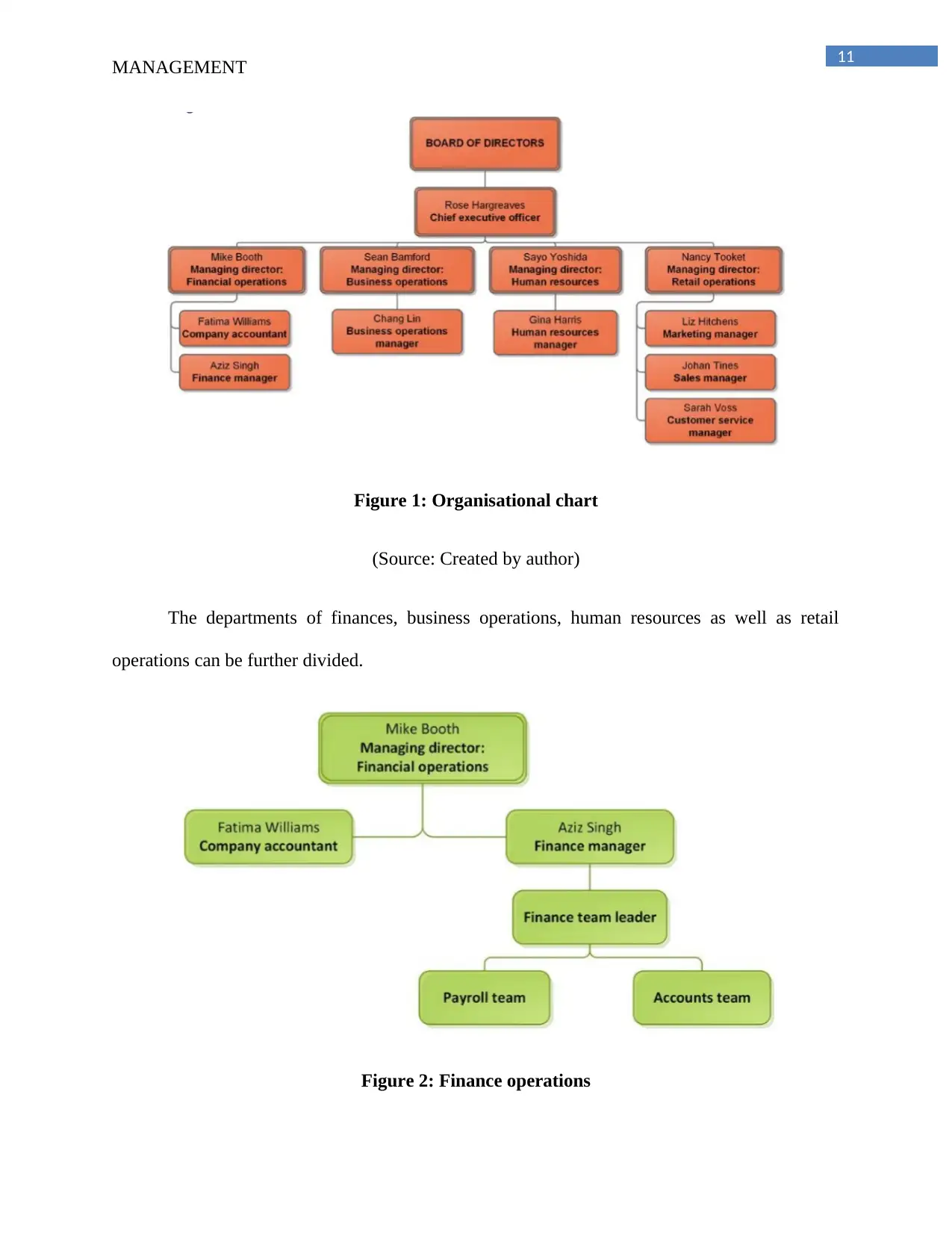
11
MANAGEMENT
Figure 1: Organisational chart
(Source: Created by author)
The departments of finances, business operations, human resources as well as retail
operations can be further divided.
Figure 2: Finance operations
MANAGEMENT
Figure 1: Organisational chart
(Source: Created by author)
The departments of finances, business operations, human resources as well as retail
operations can be further divided.
Figure 2: Finance operations
⊘ This is a preview!⊘
Do you want full access?
Subscribe today to unlock all pages.

Trusted by 1+ million students worldwide
1 out of 19
Related Documents
Your All-in-One AI-Powered Toolkit for Academic Success.
+13062052269
info@desklib.com
Available 24*7 on WhatsApp / Email
![[object Object]](/_next/static/media/star-bottom.7253800d.svg)
Unlock your academic potential
Copyright © 2020–2025 A2Z Services. All Rights Reserved. Developed and managed by ZUCOL.





